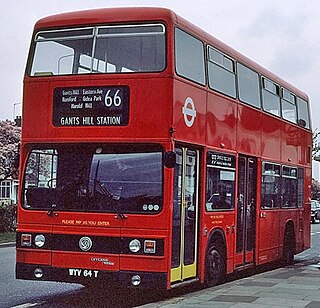
The MCW Metrobus is a two and three-axle double-decker bus manufactured by Metro Cammell Weymann (MCW) between 1977 and 1989, with over 4,000 built. The original MkI was superseded by the MkII which had a symmetrical windscreen with an arched top in 1981, although production of the original MkI continued for the Greater Manchester Passenger Transport Executive and London Regional Transport until 1983 and 1985 respectively. The Metrobus was conceived as an integral product manufactured completely by MCW, but Alexander and Northern Counties also bodied some examples.

The Scania N113 was a transverse-engined step-entrance and low-floor city bus chassis manufactured by Scania between 1988 and 2000.

The Leyland Titan is a rear-engined double-decker bus manufactured by Leyland between 1977 and 1984, primarily for London Transport.

Metro is the passenger information brand used by the West Yorkshire Combined Authority in England. It was formed on 1 April 1974 as the West Yorkshire Passenger Transport Executive (WYPTE) at the same time as the metropolitan county of West Yorkshire. The Metro brand has been used from the outset, and since the formal abolition of the WYPTE on 1 April 2014, it has been the public facing name of the organisation. The transport authority of West Yorkshire, responsible for setting transport policy, is the West Yorkshire Combined Authority. The WYCA is also responsible for delivery of transport policies.

The Dennis Dominator was Dennis's first rear-engined double-decker bus chassis, it was launched in 1977.

The Scania N112 was a transversely-engined step-entrance single-decker bus, double-decker bus and articulated bus chassis manufactured by Scania between 1978 and 1987.

Metro Cammell Weymann Ltd. (MCW), Elmdon, Birmingham, was once a major contributor in transportation manufacturing in the UK and Europe. It was established in 1932 by Metro-Cammell's bus bodybuilding division and Weymann Motor Bodies to produce bus bodies.

The Scania OmniCity is an integrally constructed transverse-engined low floor city bus that was available from Scania on the European market between 1997 and 2012.

The Volvo Ailsa B55 was a front-engined double-decker bus chassis manufactured in Scotland by Ailsa, Volvo's British subsidiary in which it owned 75%, from 1974 until 1985.

The Leyland Atlantean is a predominantly double-decker bus chassis manufactured by Leyland Motors between 1958 and 1986. Only 17 Atlantean chassis were bodied as single deck from new.

South Yorkshire Transport (SYT) was a bus operator that provided services around South Yorkshire and outlying areas. The company was formed as an 'arms-length' successor of the South Yorkshire Passenger Transport Executive (SYPTE) in 1986, which was broken up as a result of the deregulation of bus services. South Yorkshire Transport operated buses in and around Doncaster, Rotherham and Sheffield with some services extending to Chesterfield, Leeds and Barnsley.

The Daimler Fleetline is a rear-engined double-decker bus chassis which was built between 1960 and 1983.

The Northern Counties Palatine was a step-entrance 2-axle and 3-axle double-decker bus body built by Northern Counties from 1988 to 1999 in Wigan, England.

Busways Travel Services was a bus company, which operated local and regional bus services in Tyne and Wear, England. The company was purchased by the Stagecoach Group in July 1994.

Ensignbus is a bus and coach operator and bus dealer based in Purfleet, Essex. As of March 2023, it is a part of the FirstGroup.

Articulated buses, colloquially known as "bendy buses", were rarely used in the United Kingdom compared to other countries, until the turn of the millennium. This was due to a preference for the double-decker bus for use on high capacity routes. In June 2006, there were over 500 articulated buses in the United Kingdom, although they were still heavily outnumbered by double deckers. The majority of this fleet was used in London, although these buses would be withdrawn by end of 2011.

The AEC Swift was a rear-engined step entrance single-decker bus chassis manufactured by AEC between 1964 and 1980. The chassis design was closely related to the Leyland Panther. It was available in 33-foot (10 m) and 36-foot (11 m) lengths, with an AEC AH505 or AH691 engine.

The Leyland Panther was a rear-engined single-decker bus chassis manufactured by Leyland between the years 1964 and 1972. A version with a smaller engine was released as the Leyland Panther Cub.

The Alexander PS-type was a step-floor single-decker bus body built by Walter Alexander Coachbuilders in Falkirk, Scotland and was produced from 1988 to the late 1990s predominantly on the Dennis Lance, Mercedes-Benz O405, Scania N113, Volvo B10M chassis.

The Metro-Scania was a step-entrance single-deck bus body manufactured by Metro Cammell Weymann and Scania between 1970 and 1973.























